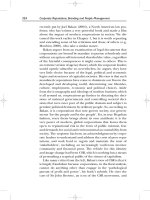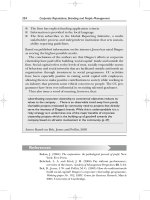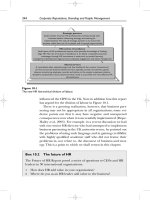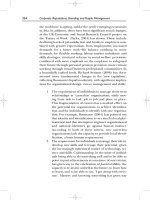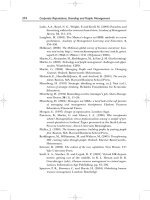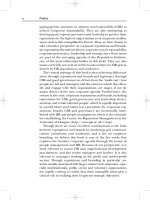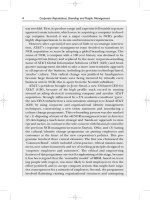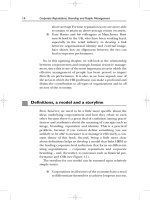Tài liệu Corporate Reputations, Branding and People Management 17 doc
Bạn đang xem bản rút gọn của tài liệu. Xem và tải ngay bản đầy đủ của tài liệu tại đây (127.43 KB, 10 trang )
have worked. On hearing of the proposed layoff, in a deliberate
act of sabotage these apprentices systematically removed all the
cabling and equipment they had installed. Pfeffer (2005) argued
that this response to leadership was becoming more common in
the USA.
Commitment
In our case on the North Sea oil industry (Box 4.1), our measures
of employees’ relationships with their organization focused
mainly on commitment, a term that is used to refer to a number
of different attachments to work, including commitment to work
itself, to specific jobs, to a union or workgroup, to a career or pro-
fessional calling, or to the employing organization(s). It is the last
of these that has received most attention because it has promised
much in measuring, a little like engagement, nearly all important
aspects of the employment relationship and desired organi-
zational outcomes, such as loyalty, ‘going the extra mile’ (organi-
zational citizenship behaviour), low absenteeism and good
performance. However, for the same reason we criticized engage-
ment as a rather blunt instrument, commitment (at least some
versions of it) also falls into that category (Reade, 2001). This is
the reason we prefer to use the additional measures of psycho-
logical contracts, identification, internalization and ownership.
Organizational commitment is sometimes thought to have
three components, which are set out in Box 4.5. An individual’s
commitment can be made up of one or more of these types of
commitment, and usually a composite measure of all three is
provided in general surveys.
144 Corporate Reputations, Branding and People Management
Box 4.5 Three types of organizational commitment
■ Affective (or attitudinal) commitment, which is based on a willing
acceptance of the organization’s goals and an identification or emo-
tional attachment with the organization and its values. Measures
include items like ‘I really feel as if this organization’s problems are
my problems.’
Chapter 4 The quality of individual employment relationships 145
There are several problems, however, with the notion of organ-
izational commitment that render it a less useful concept in
describing the strength of the relationship between individuals
and their organization, especially in contemporary contexts
(Swailes, 2002). First, it is used as both an explanation and an
outcome of individual–organizational linkages. Since it aggre-
gates a number of different ideas, it is not easy to develop a sound
explanation of what may cause commitment (Reade, 2001). As
an illustration, what may cause people to remain with an organ-
ization (continuance commitment) may be different from what
causes people to identify with it or be loyal to it, e.g. lack of
opportunities elsewhere. Second, the notion that employees
may be committed to only one organization, especially in the
light of recent changes towards networking in organizations and
in the light of boundaryless careers discussed earlier, may be
becoming outmoded. Third, the goals and values of a large
organization are likely to vary from one part to another, such as
in those organizations that have strong lines of business brands,
and rejection of one specific value (or line of business brand)
may coexist with the acceptance of other values (or other lines of
business). This could be the case, for example, with organiza-
tions that have ethically dubious products such as cigarettes as
part of their portfolio.
Perhaps more than anything, however, the reason to be a little
wary of the concept of commitment is its promised relationship
with desirable organizational outcomes. Although high levels of
continuance commitment have been shown to be related to
■ Continuance commitment, which refers to the extent to which
employees are bound to the organization in terms of their intention
to remain or leave. This may result from a weighing up of the costs
and benefits of staying or leaving, such as perceptions of alternative
jobs, or the financial hardship associated with leaving. Measures
include items like ‘I would continue to work for this organization even
though I received a better offer from another employer.’
■ Normative commitment, which refers to an individual’s perceptions
of obligation or loyalty to the organization. Measures include items
like ‘This organization deserves my loyalty.’
Source: Based on Meyer and Allen, 1991
146 Corporate Reputations, Branding and People Management
lower labour turnover and absence, and affective commitment
has been shown to be associated with job performance, the links
between organizational commitment as a whole and perform-
ance are really quite weak (Sparrow and Cooper, 2003). Also
given the changes in the nature of employment discussed in the
previous paragraph and throughout this course, even this weak
relationship may diminish over time. So, we prefer to define and
use commitment as the reasons underlying people’s wish to
remain with an organization (Pierce et al., 2001).
Bringing them altogether
Pierce et al. have compared and contrasted the four concepts of
commitment, identification, internalization and ownership, the
outcomes of which are highly relevant to managers who hope to
manage psychological contracts and individuals’ attachment to
their organizations. We have adapted their table to highlight
the most important practical implications (see Table 4.5).
Engagement and supportive
behaviours
As Table 4.5 shows, identification, internalization, ownership
and commitment are really causes of what employers are usu-
ally looking for, which are competent and relevant behaviours
that translate these emotions, attitudes and understandings
into action, e.g. satisfying customers, sharing knowledge and
increased effort. Over the past few years, HR professionals and
consultants have begun to use the concept of employee
engagement as a way of adapting these well-known psycho-
logical concepts to the practical concerns of aligning HR with
the business agenda. Like any other immature idea that prom-
ises a lot to managers, engagement has caused some contro-
versy over what it means and, as we have shown in our
discussion of commitment, fuses a number of different ideas
together, not always successfully. Until recently, there has been
very little academic research on this largely consultancy-driven
Table 4.5
The differences between commitment, identification and psychological ownership.
Criteria for Organizational Organizational
Internalization Psychological
distinctiveness commitment identification
ownership
Core proposition or Desire to remain with Use of organization’s Oneness with the Possession of the
concept organization identity to define oneself organization’s goals and ‘organization’,
job or
values area of work
Questions answered Should I remain? Who am I?
What do I believe? What is mine?
for individuals
Motivational bases Security Attraction Need to distinguish Control
Belongingness Affiliation between right and wrong Self-identity
Beliefs and values Self-esteem Moral and ethical Need for place
How it develops Decision to remain with Incorporating organizational
Integration of Active imposition/
organization Self values into self organization’s values investment of self on
Affiliation Affiliation and goals organization
Emulating organizational
characteristics
Main consequences Organizational citizenship Support for organizational
Organizational citizenship Development of employee
for practitioners behaviour (‘going the values and participation in behaviour rights and responsibilities
from research extra mile’) its activities Intention to leave or Promotion of/resistance to
findings Intention to leave or Intention to remain remain change
remain Frustration/stress Engagement behaviours Frustration, alienation and
Attendance and Alienation
sabotage
absenteeism Lack of integration into Integration of employees
organizational with
work
values/culture Organizational
citizenship behaviours
Source: Adapted from Pierce et al., 2001, p. 306
concept, perhaps because it overlaps with other, more estab-
lished ideas in the psychological and management literature,
such as the ones we have already discussed and others like
organizational climate and citizenship. Given that it has caught
the imagination of practitioners, however, it is worth examin-
ing to see what it can offer us in terms of a more complete
picture of the identity–image relationship and its links to repu-
tations, brands and performance outcomes.
To make our position clear on this issue, our view is that
engagement, or certain versions of it, is helpful because it offers
an insight beyond emotions and attitudes such as those typically
measured by conventional surveys. There are two reasons for
this judgement, both identified by Robinson, Perryman and
Hayday (2004) in their UK-based Institute of Employment
Studies report. First, it invokes the idea of specific behaviours
associated with identification, internalization and commitment
that demonstrate business awareness and a willingness to pro-
mote the interests of the business. Second, like psychological
contracts, it invokes the idea of a two-way employment relation-
ship; engagement does not occur in a managerial vacuum,
employers have to work at engaging employees just as employees
have to work at being engaged.
Like most of the models we’ve discussed in the previous two
chapters, the justification for engagement lies in one version or
another of the people–performance link, or even directly in the
service–profit chain. A close examination of the various consult-
ing tools and the ideas that underpin them reveals some simple
but powerful messages that are increasingly supported by their
own research or by those independent academics who have
been given access to their data. Towers Perrin, one of the major
HR consultancy organizations, is a good example, with its link-
age framework showing how engagement relates to business per-
formance (see Figure 4.3).
Gallup Consulting, another major player in promoting engage-
ment, has developed the Gallup Path, tracing a causal link bet-
ween: (1) the identification of employee strengths; (2) the right
fit between the person and the job; (3) great managers; (4)
engaged employees; (5) engaged customers; (6) sustainable
growth; (7) real profit increase; and (8) stock increases. Based
on many years of survey research undertaken for companies
148 Corporate Reputations, Branding and People Management
throughout the world, they have shown a plausible connection
between improvements in the first five of these and improve-
ments in the last three. This connection has been supported by
US academic researchers using the Gallup data; they found
that aspects of well-being at work, including job satisfaction but
especially ‘engaged employees, on average, do a better job of
keeping employees, satisfying customers, and being financially
productive and profitable’ (Harter et al., 2002, p. 16). It should
be noted, however, that these researchers were a little more
circumspect about the lines and direction of causality and the
role that might play in this relationship.
Defining engagement
Various consultancy companies and writers on this subject
define engagement in different ways, as the preceding discus-
sion has implied. For example, Harter et al.’s (2002) more aca-
demic approach sees engagement as an element of a broader
category of ideas known as well-being at work, which embraces
emotional and cognitive (knowledge acquisition) elements.
They view engagement as a driver of intermediate outcomes
such as job satisfaction, commitment, fulfilment, caring and posi-
tive behaviours. However, most consultants stress behavioural-
related dimensions to work as well as the cognitive dimensions.
For instance, Towers Perrin (2003) see engagement as invoking
emotional and rational factors relating to work and the overall
Chapter 4 The quality of individual employment relationships 149
People programmes
and services
Examples
Employee
behaviour
Examples
Engagement
Customer
service
Productivity
Turnover
Customer
behaviour
Examples
Loyalty
Repeat
purchases
Company
advocacy
Wallet share
Business
performance
Examples
Revenue
growth
Earnings
before tax
Stock
performance
Rewards
HR service
delivery
Workforce
deployment
Figure 4.3
The Towers Perrin Linkage Framework (reprinted by permission from
Towers Perrin).
experience of work: emotional factors are linked with ‘staff satis-
faction, a sense of inspiration and the affirmation they get from
their work and from being part of an organization’. Rational fac-
tors relate to people’s understanding of their job, the unit for
which they work and how their performance relates to business
performance.
Similarly, the Institute of Employment Studies (IES) in the
UK, in probably the best review of the topic to date, reflect these
emotional, cognitive and behaviourally related dimensions in
their definition and approach to engagement (Robinson et al.,
2004). Rather unhelpfully, however, they have defined engage-
ment as a ‘positive attitude held by the employee towards the
organization and its values …’ (p. 9). More usefully, they also
define an engaged employee as one who has an understanding
of the business context in his or her organization and works
with colleagues to behave in a performance-enhancing manner
for the benefit of the organization. In return, the organization
has to work with employees to engage them in more than a
transactional relationship.
Measuring engagement
Given the range of definitions, not surprisingly there are dif-
ferent items used to measure engagement. Table 4.6 below sets
examples from three sources – Gallup Consulting, Hewitt
Associates and the IES – in a little more detail, analysing them
into items most closely related to (a) emotions and feelings
connected with identification, commitment and ownership,
(b) understanding and beliefs about their organizational roles
and its image, and (c) behaviours and behavioural intentions.
Each approach has items in all three categories; probably the
main difference between them is that Gallup is more inclined
to include behaviours that stress the obligations of employers
to employees in fulfilling psychological contracts, whilst the
IES lays more stress on employees demonstrating organiza-
tional citizenship-type behaviours. Hewitt Associates have less
of a focus on behaviours and more on emotions, feelings and
understanding.
150 Corporate Reputations, Branding and People Management
Chapter 4 The quality of individual employment relationships 151
Table 4.6
Items used to measure engagement and different approaches.
Items used to measure engagement Gallup Hewitt IES
Emotions and feelings
Closely identify with values of organization [x]
Trust senior leaders to balance employee interests [x]
with those of company
Proud to tell others I am part of company [x] [x]
My opinions at work count
The purpose/mission of organization makes me value [x] [x]
my job
Feel confident about future success of organization [x] [x]
Have a best friend at work [x]
Feel confident that organization is making appropriate [x]
changes for future
Feel products/services provide real value/benefits to [x]
customers
Understanding and beliefs
Colleagues committed to quality [x]
Know what is expected of me [x] [x]
Have right materials/information to do job [x] [x]
Given opportunity to do my best at work everyday [x]
Organization known as good employer [x]
Organization has a good reputation [x]
Understand organization’s goals [x]
Behaviours
Regularly receive recognition and praise for doing [x]
good work
Supervisor or mentor takes care of me as a person [x]
Receive encouragement to develop myself [x]
Have received recent opportunities to develop [x]
Have received recent appraisal [x]
Would recommend organization’s products and services [x]
Speak highly of organization to friends [x]
(continued)
Like most work on engagement, all three approaches show
impressive degrees of correlation with performance measures,
as illustrated by our earlier discussion of the Gallup approach
and the validation work by the US academics. The IES study
shows why this might be the case in mapping their engagement
measures with what they present as the characteristics of an
engaged employee (see Table 4.7).
152 Corporate Reputations, Branding and People Management
Table 4.6
(Continued)
Items used to measure engagement Gallup Hewitt IES
Frequently make suggestions to improve team/
department performance [x]
Always do more than is required [x]
Try to help others in organization [x]
Try to keep abreast of current developments in my area [x]
Volunteer to do things outside of job requirements to
contribute to organization [x]
Table 4.7
Mapping of employee engagement with the characteristics of an engaged employee.
Characteristics Statement
The Engaged Looks for and is given The organization really
Employee opportunities to improve inspires the very best in me
organizational performance in the way of job performance
Is positive about the job I speak highly of this
and organization organization to my friends
The organization has a good
reputation
I would be happy for my
family and friends to use the
organization’s products and
services
Believes in the This organization is known
organization as a good employer
Works actively to improve I frequently make suggestions
things to improve the work of my
team/department/service
Chapter 4 The quality of individual employment relationships 153
Characteristics Statement
Treats others with respect I try to help others in this
and helps colleagues to organization whenever I can
perform better
Can be relied on, and goes I always do more than is
beyond contract required
Sees the bigger picture, I volunteer to do things
even at personal cost outside my job that con-
tribute to the organization’s
objectives
Identifies with organization I find my values and the
organization’s are very similar
I am proud to tell others
that I am part of the
organization
Keeps up-to-date with I try to keep abreast of
developments in their current developments in
field my area
Let’s look at another case we researched for the book that
used a measure of employee engagement in its attempt to
re-brand itself. Before we conclude this chapter, you may wish
to reflect on the strengths and weaknesses of their approach in
the light of our discussions in this and previous chapters.
Box 4.6 Linking branding and HR at Standard Life
Investments
Standard Life Investments, which is headquartered in Edinburgh,
Scotland, was launched in 1997 as an autonomous organization within
the Standard Life group of companies with the aim of becoming a major
international investment house. Since then it has achieved impressive
results and has major offices in London, Montreal, Boston, Hong Kong
and Dublin and representative offices in Beijing and Seoul, and currently
employs around 650 staff. Part of the company’s success has been based
on establishing a strong corporate brand in the investment market, which
has been fully supported by the HR team in Edinburgh in their combined
Source: Adapted from Robinson et al., 2004, p. 15
